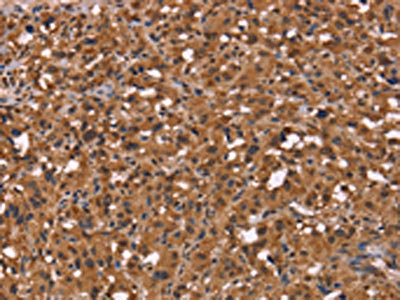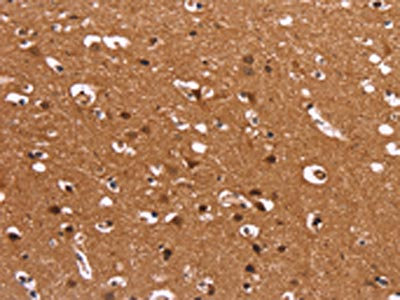HDLBP Antibody
-
货号:CSB-PA876442
-
规格:¥1100
-
图片:
-
The image on the left is immunohistochemistry of paraffin-embedded Human thyroid cancer tissue using CSB-PA876442(HDLBP Antibody) at dilution 1/50, on the right is treated with synthetic peptide. (Original magnification: ×200)
-
The image on the left is immunohistochemistry of paraffin-embedded Human brain tissue using CSB-PA876442(HDLBP Antibody) at dilution 1/50, on the right is treated with synthetic peptide. (Original magnification: ×200)
-
Gel: 6%SDS-PAGE, Lysate: 40 μg, Lane: NIH/3T3 cells, Primary antibody: CSB-PA876442(HDLBP Antibody) at dilution 1/750, Secondary antibody: Goat anti rabbit IgG at 1/8000 dilution, Exposure time: 1 minute
-
-
其他:
产品详情
-
Uniprot No.:Q00341
-
基因名:HDLBP
-
别名:HBP antibody; HDL binding protein antibody; HDL-binding protein antibody; HDLBP antibody; high density lipoprotein binding protein antibody; high density lipoprotein binding protein (vigilin) antibody; High density lipoprotein-binding protein antibody; PRO2900 antibody; VGL antibody; Vigilin antibody; VIGLN_HUMAN antibody
-
宿主:Rabbit
-
反应种属:Human,Mouse,Rat
-
免疫原:Synthetic peptide of Human HDLBP
-
免疫原种属:Homo sapiens (Human)
-
标记方式:Non-conjugated
-
抗体亚型:IgG
-
纯化方式:Antigen affinity purification
-
浓度:It differs from different batches. Please contact us to confirm it.
-
保存缓冲液:-20°C, pH7.4 PBS, 0.05% NaN3, 40% Glycerol
-
产品提供形式:Liquid
-
应用范围:ELISA,WB,IHC
-
推荐稀释比:
Application Recommended Dilution ELISA 1:2000-1:5000 WB 1:500-1:2000 IHC 1:100-1:300 -
Protocols:
-
储存条件:Upon receipt, store at -20°C or -80°C. Avoid repeated freeze.
-
货期:Basically, we can dispatch the products out in 1-3 working days after receiving your orders. Delivery time maybe differs from different purchasing way or location, please kindly consult your local distributors for specific delivery time.
相关产品
靶点详情
-
功能:Appears to play a role in cell sterol metabolism. It may function to protect cells from over-accumulation of cholesterol.
-
基因功能参考文献:
- Our data reveal that vigilin is essential for maintenance of imprinting of IGF2 gene via functional interaction between KH1-7 domains of vigilin and zinc-finger domains of CTCF. PMID: 29157910
- vigilin has been shown to bind over 700 mRNAs and has been associated with cancer progression and cardiovascular disease. PMID: 28975734
- this study shows that vigilin (HDLBP) binds and negatively regulates MICB expression through its 5'UTR, and that vigilin downregulation in target cells leads to NK cell activation against said target cells PMID: 28356383
- progressively upregulated vigilin may serve as a molecular risk marker for hepatocellular carcinoma development, and targeting vigilin may help to inhibit hepatocellular carcinoma cell growth, survival and migration. PMID: 24676454
- CTCF may regulate vigilin behavior and thus indirectly influence the binding of HP1alpha to the satellite 2 locus PMID: 24561205
- Vigilin may have a relationship with hepatocellular carcinoma progression and proliferation. PMID: 21500547
- identified a competition for binding the 69-nt sequence, through which vigilin and HuR exert opposing effects on c-fms expression, suggesting a role for vigilin in suppression of breast cancer progression PMID: 20974809
- Expression profiles of human VIGILIN, H19, and IGF2 mRNA increased with cell-cycle prograssion. PMID: 19950580
- RNA interference studies indicate vigilin is essential for cell viability but is not a global regulator of translation. PMID: 14500828
- evidence that vigilin is bound to the ribosomal complex. PMID: 15109574
- C-terminal domain of human vigilin binds to the histone methyltransferase SUV39H1 in vivo;a new model for vigilin-mediated, RNA-induced gene silencing is presented. PMID: 18648073
显示更多
收起更多
-
亚细胞定位:Cytoplasm. Nucleus.
-
数据库链接:
HGNC: 4857
OMIM: 142695
KEGG: hsa:3069
STRING: 9606.ENSP00000312042
UniGene: Hs.471851
Most popular with customers
-
-
YWHAB Recombinant Monoclonal Antibody
Applications: ELISA, WB, IF, FC
Species Reactivity: Human, Mouse, Rat
-
Phospho-YAP1 (S127) Recombinant Monoclonal Antibody
Applications: ELISA, WB, IHC
Species Reactivity: Human
-
-
-
-
-























